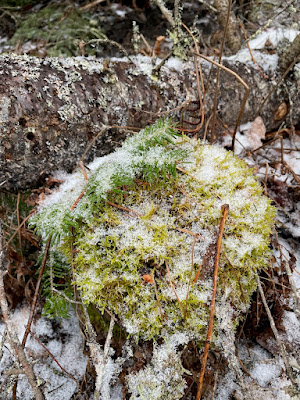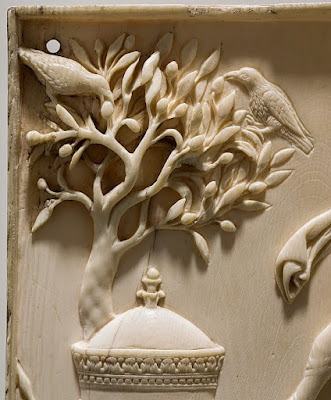I used to think there were Triduum people and Easter Sunday people (long one of the latter, I only dedicated to the former when I moved to NYC) and felt a little sorry for the clergy and others who had to be there for all of them. But this year choir duty makes me one of those people, so I was there bright and early today for the fifth leg of the Holy Week pentathlon. Glad I went! Yes, it it sort of a victory lap, the strife over and the battle won already at last night's vigil. And yes, today's church was full of unfamiliar faces - but also full, as we never usually are. (Why don't they join us more often? We have room!) Do they know we turned the church inside-out, clergy washing lay feet, the altar stripped, lights extinguished, and then celebrated the return  of the light with candles? I didn't, before I became a Triduumite. But somehow none of this mattered, or maybe it even contributed to the giddy joy of the morning. The work was done, we'd been there for it, we were there together, the world has no idea. The point of Easter is just to say "Alleluia" as many times and ways as you can anyway, isn't it? The musical selections helped, too, including old chestnuts like "Jeusus Christ is Ris'n Today," "Good Christians All, Rejoice and Sing" and, yes, "The Strife is Over" and the Easter hat of the organ repertory, the toccata from Widor's 5th symphony for organ but also some Bach and the spiraling euphoria of some modern gospel - with probably the first guest saxophonist in our church's history. What a nifty place! Maybe some of the fair-weather Christians got the vibe?
of the light with candles? I didn't, before I became a Triduumite. But somehow none of this mattered, or maybe it even contributed to the giddy joy of the morning. The work was done, we'd been there for it, we were there together, the world has no idea. The point of Easter is just to say "Alleluia" as many times and ways as you can anyway, isn't it? The musical selections helped, too, including old chestnuts like "Jeusus Christ is Ris'n Today," "Good Christians All, Rejoice and Sing" and, yes, "The Strife is Over" and the Easter hat of the organ repertory, the toccata from Widor's 5th symphony for organ but also some Bach and the spiraling euphoria of some modern gospel - with probably the first guest saxophonist in our church's history. What a nifty place! Maybe some of the fair-weather Christians got the vibe?
Sunday, March 31, 2024
Strife over
Saturday, March 30, 2024
Friday, March 29, 2024
Thursday, March 28, 2024
Lifelong?
Wednesday, March 27, 2024
雪だるま
Tuesday, March 26, 2024
Monday, March 25, 2024
Tree of extinction

Sunday, March 24, 2024
Saturday, March 23, 2024
Shortcuts
Friday, March 22, 2024
Forest succession
The replanting of the courtyard has commenced, and it's beautiful. Here the view down from my office window two weeks ago and today.
The exposed soil will be planted with green ground cover (as when the courtyard was first laid out), making for a quite different feel. (Vines have been promised, too!) Also: the courtyard we knew was a space of monocultures - red maples here, a stand of bamboo opposite, later replaced by one and then another kind of tree. The new look is mixed. You can't quite see from above but among the evergreen shrub with fragrant yellow flowers (Japanese mahonia, I think) are some new young trees. They appear to be the same kind as some new ones planted across the courtyard, which still bore ID as American hophornbeam, together with two other kinds of trees. Diversity on both ends, and some commonality of trees - a whole new concept!Thursday, March 21, 2024
Non SPE
Wednesday, March 20, 2024
Turtle islands
Tuesday, March 19, 2024
Barnstorm
Sunday, March 17, 2024
Gifts of vocation
Breeding lilacs out of the dead land
 April used to be the cruellest month, but (one of our alums writes) now plants bud an average of 18 days earlier than in the 1950s.
April used to be the cruellest month, but (one of our alums writes) now plants bud an average of 18 days earlier than in the 1950s.
Thursday, March 14, 2024
Precursor
In any case, Mrs. Philpot published The Sacred Tree: Or, The Tree in Religion and Myth in London in 1897. It is pretty much the book on the subject for most of the next century, at least in English, which say as much about the topic as about her treatment of it. (Nathaniel Altman's Sacred Trees will appear in 1994.) It is in fact an impressive work of synthesis, bringing together research from archaeology, folklore, classic literature and "contemporary anthropology" in multiple European languages. Important emergent theories of the evolution of religion are mentioned too: Tylor, Spencer and Frazer.
Philpot says she’s writing her book because
no other form of pagan ritual has been so widely distributed, has left behind such persistent traces, or appeals so closely to modern sympathies as the worship of the tree (vii)
Just what "modern sympathies" she has in mind is not, alas, made clear, nor whether the enduring appeal of the “worship of tree” is a source of hope or fear.
The Sacred Tree sets the stage with Chaldean images of pairs of worshipping figures—often real or mythical animals—facing a central stylized tree, an image to be found even in the cathedral of St. Mark’s in Venice. There are traces everywhere of these ancient practices. Philpot then touches quickly on Canaan and ancient Israel, contemporary Africa, ancient Egypt and Persia, India and Southeast Asia ancient and contemporary, Japan and the western hemisphere from Mexico to the Great Lakes to Patagonia. She returns to Europe, moving from the Germanic forests to Poland, Russia, Finland and France before alighting in May tree celebrations in England. Everywhere she finds illustrations of
the primitive idea that there was a spiritual essence embodied in vegetation, that trees, like men had spirits, passing in and out amongst them, which possessed a mysterious and potent influence over human affairs, and which it was therefore wise and necessary to propitiate (3).
In the following we encounter the coffin of Osiris found in a tree, Indian tree veneration remarked already in Alexander’s time, oaks of the Druids and at Dodona, the trees of the several Buddhas, customs of hanging gifts and trophies on trees going back to the Golden Fleece, use of wreaths and branches in religious as well as domestic ceremonies, practices of placing sick childen in the clefts of trees, trees which bleed and others which produce intoxicating potions, a cavalcade of wild men, elves, djinn, fauns, nymphs, dryads, fairies, pixies and moss-women, spring festivities and, inevitably, Christmas trees.
This teeming multiplicity manifests in various forms, which Philpot deftly organizes under several headings. She devotes a chapter each to "tree gods" friendly to humans – really gods who make their abode in trees - and indifferent or hostile "wood-demons and tree-spirits,” parrying on the question if one developed from the other. What is clear is that these tree-connected spirits
preceded the gods and outlasted them (53)
just as ancient tree shrines outlasted the temples built next to them. Next she adduces examples of practices which connect trees with human life - its origin, its key transitions, its end, etc. - and cases where trees serve as oracles. She mentions as a possible source of tree veneration the use of intoxicants from tree substances used by seers.
She turns next to what she calls the “universe tree,” a variant of what will become known as the axis Mundi, the pillar separating - and connecting - sky and earth. Primitive folks will have wondered why celestial objects aren't subject to gravity like everything else, she quips, but acknowledges that not all peoples imagine a tree pillar. Sacred mountains serve for many, but flatlanders prefer trees. The universe tree shades into the tree of life, and that leads to ideas of paradise, whether as a home of gods or the beginning or end of human life.
[O]riginally the mystical tree was the essential feature of paradise, and the garden was merely its precinct or setting—one of the many conceptions which grew up around the central idea of the cosmic tree. Each nation, according to its stage of culture or its prevailing habit of thought, emphasized one feature of it. The monster tree which, according to primitive cosmogony, was believed to support the universe by material branches, became in the minds of more cultivated races the central tree of a dimly-realised paradise, and eventually the symbol of an abstract idea. The intellectual Buddhist saw in it the emblem of knowledge; the Persian thought of it as the tree of immortality; the Hebrew, filled with the idea of man’s frailty and with the longing to explain it, made it the tree of temptation.
But in all these various conceptions we find a central idea, derived no doubt from an antecedent and universal tree-worship, an idea which places a tree at the root of all philosophy, refers all phenomena to the existence of a central tree, serviceable to man here and hereafter, and concentrating upon itself the reverent devotion which had outgrown its earthly counterpart. (142)
From these lofty heights the book's final sections turn to practices in her own British Isles. She describes the boisterous celebrations at the arrival of spring, and folk practices to commemorate it, notably involving May trees. These have a dark edge, she notes – it seems the May King was once sacrificed – but Philpot is not James Frazer, and she move on. May day practices largely lost their religious meaning since the Puritans banned them, she notes. Yet as pagan May revels subsided Christmas has given trees a new meaning, this time on the side of spirituality rather than paganism.
Modern as it is in its present form, the Christmas-tree epitomizes many most ancient ideas; is the point to which many streams converge whose source is hidden in a far-distant antiquity. It is the meeting-point of the old pagan belief in the virtues vested in the tree and of the quaint fancies of the Middle Ages, which loved to see spiritual truths embodied in material forms. Christ, the Tree of Life, blossoming on Christmas-eve in Mary’s bosom; the fatal tree of paradise whence sprang the cross, the instrument of man’s salvation …; the miracle of nature, so stirred by the wonder of the event as to break forth into blossom in the midst of winter—all these ideas, so characteristic of mediaeval thought, became grafted together with observances derived from solstitial worship, upon the stock of the sacred tree, laden with offerings and decked with fillets. Indeed, the Christmas-tree may be said to recapitulate the whole story of tree-worship,—the May tree, the harvest-tree, the Greek eriesione, the tree as the symbol and embodiment of deity, and last but not least, the universe tree, bearing the lights of heaven for its fruit and covering the world with its branches. (172-73)
Grafting all of the varieties she has gathered onto the rootstock of the “sacred tree,” this yuletide denouement comes as something of a surprise. (These are the last words of the book.) Frazer’s Golden Bough found Christianity to be no more than a particularly long-lived example of the human sacrifice at the heart of the worship of trees. Philpot has domesticated and converted the whole history. And if her theology isn’t one to allow intimations of immortality in “paganism,” a properly civilized paganism can yet perhaps play a part in true religion. It's all very… Victorian.
But where are the trees? As Philpot assembles examples from (she avers) across time and place, we encounter practices and myths engaging cedar, palm, sycamore, cotton-tree, acacia, myrrh-tree, pine, cypress, myrtle, plane, bamboo, ficus religiosa, sakaki, cypress, oak, birch, mountain-ash, pear-tree, alder ... But their differences matter not. Her tree worshippers' relationships were never with the trees themselves, but with the gods or spirits which made their home there. That particular trees or tree species might have had something to do with all this is inconceivable to her, because actual relationships with actual trees have already been effaced by her "civilization."
Wednesday, March 13, 2024
Covid knocking at the door
Tuesday, March 12, 2024
Graft the gap
Sunday, March 10, 2024
Thursday, March 07, 2024
Tuesday, March 05, 2024
More miracle
At this week's Crossan and Friends, the special guest was recovered evangelical Brian McLaren, who started us off with a poem (he called it a sort of haiku) that he'd just written. Not Szymborska but lovely.
I do not walk on water
Except in winter,
When ice makes the miracle more natural.
To me, these days, natural miracles are better,
Signifying lessons to live rather than shortcuts to take,
A more subtle yet more real magic.
For me, nature is already as supernatural
As it needs to be.
The simplest, humblest things —
Green moss on grey rock,
Spotted turtle basking in a shaft of sunlight —
They are true signs and wonders,
Holy, significant, wonderful.
I used to crave miracles to prove something
(most especially, myself, my faith, my tribe’s exceptionalism).
Now, instead of the miracle,
I try to keep my eyes open for the meaningful.
That these sounds in air or these marks on paper
Could bear my heart to yours,
Or bring what you see to my eyes … what
Could be more miracle?






































.jpg)








